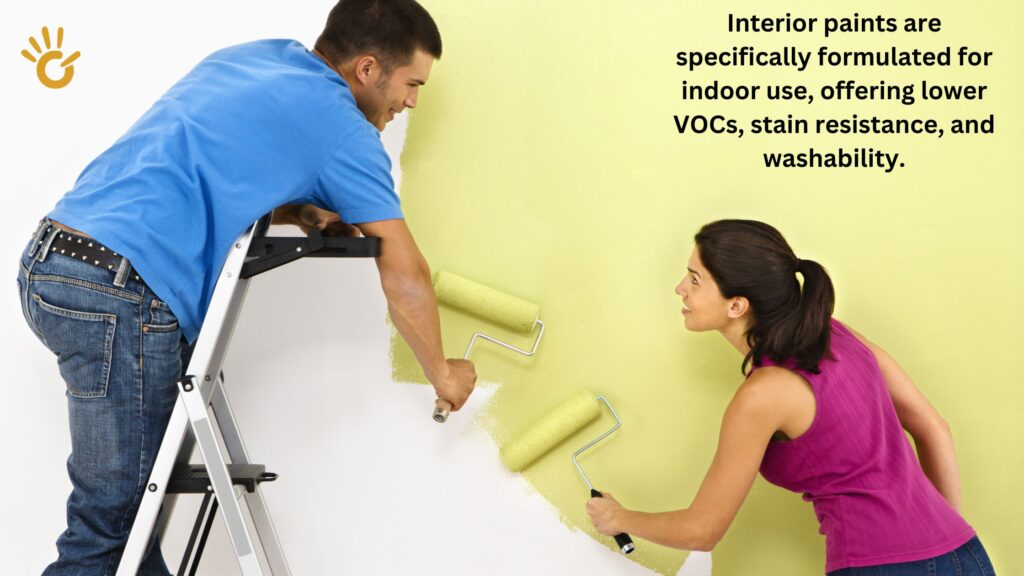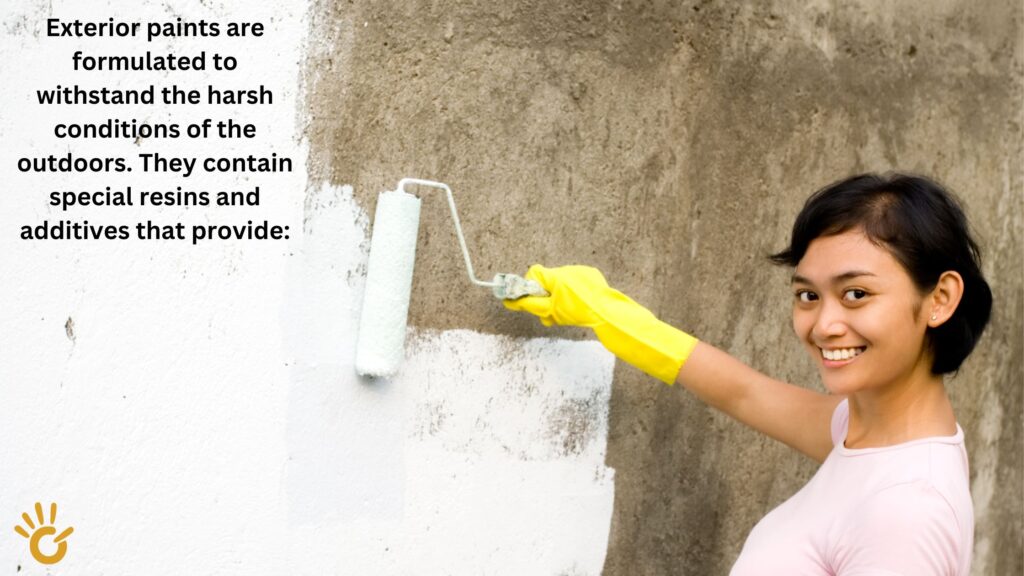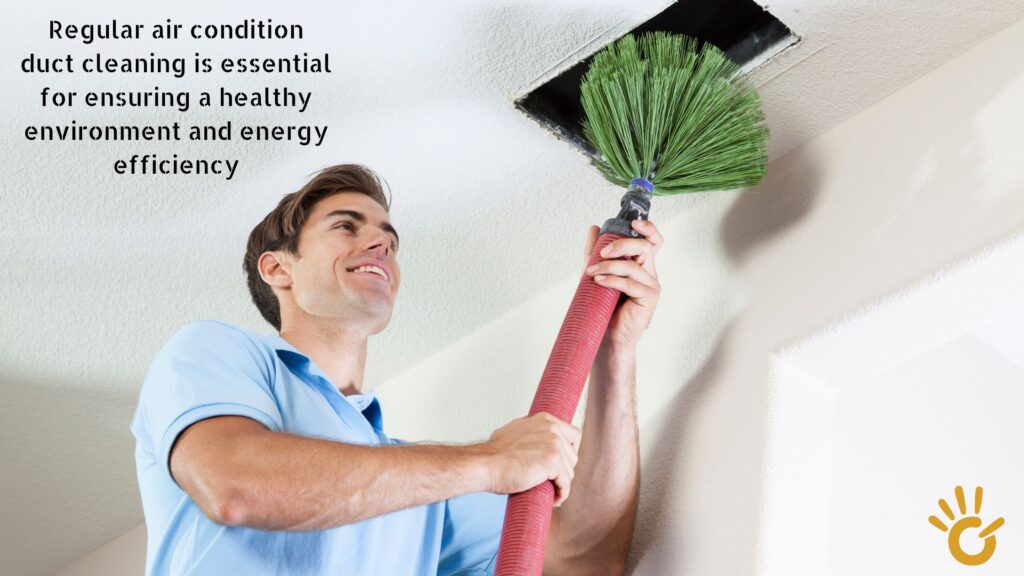Imagine finding the perfect paint color for your living room, but it’s labeled for exterior use. Can you use it anyway? While it might be tempting to grab that leftover can of exterior paint for an indoor project, doing so can pose significant health risks. Understanding the key differences between interior and exterior paints is crucial for protecting your health and ensuring the best results for your painting project.
Understanding the Differences Between Interior and Exterior Paint
What Makes Exterior Paint Different?
Exterior paints are formulated to withstand the harsh conditions of the outdoors. They contain special resins and additives that provide:
● Weather Resistance: Exterior paints are designed to resist fading, cracking, and peeling caused by exposure to sunlight, rain, wind, and extreme temperatures.
● Mildew Prevention: Fungicides and mildewcides are added to exterior paints to prevent the growth of mildew and mold in damp environments.
● UV Protection: Exterior paints contain pigments that are resistant to fading caused by the sun’s ultraviolet (UV) rays.
● Durability: Exterior paints are typically thicker and more durable than interior paints, making them better able to withstand scratches, scuffs, and impacts.
To achieve these properties, exterior paints often contain higher levels of volatile organic compounds (VOCs). VOCs are chemicals that evaporate into the air and can have negative health effects.
What Makes Interior Paint Different?
Interior paints are designed for indoor use and prioritize different performance characteristics:
● Low VOCs: Interior paints are formulated to have much lower levels of VOCs, making them safer for indoor use.
● Stain and Abrasion Resistance: Interior paints are designed to resist stains, scuffs, and scratches that commonly occur in indoor environments.
● Washability: Many interior paints are washable, allowing for easy cleaning.
Why You Shouldn’t Use Exterior Paint Inside (Most of the Time)
The primary reason to avoid using exterior paint indoors is the high level of VOCs. When exterior paint dries, it releases these harmful chemicals into the air, which can pose health risks, especially in enclosed spaces with poor ventilation.
Exposure to high levels of VOCs can cause:
● Short-Term Effects: Eye, nose, and throat irritation, headaches, nausea, dizziness, and difficulty breathing.
● Long-Term Effects: Liver, kidney, and central nervous system damage, and an increased risk of certain cancers.
Even after exterior paint dries, it can continue to release VOCs for an extended period. This off-gassing makes the indoor air quality poor and can be especially harmful to people with allergies, asthma, or other respiratory problems.
In addition to health risks, using exterior paint indoors can be more expensive since exterior paint is typically pricier than interior paint.
Can You EVER Use Exterior Paint Inside?
Exceptions to the Rule
While using exterior paint indoors is generally not recommended, there are a few exceptions where it might be considered, but with extreme caution:
H4: Garages and Sheds
Garages and sheds are often less occupied and better ventilated than other areas of the home, which can help to minimize VOC exposure. If you’re looking for extra durability in these spaces, using exterior paint might be an option. However, it’s still essential to ensure adequate ventilation during and after painting.
H4: Bathrooms and Basements
Moisture-prone areas like bathrooms and basements can benefit from the mildew-resistant properties of exterior paint. However, it’s crucial to choose a low-VOC exterior paint and prioritize ventilation to reduce health risks. Allowing ample drying time and ensuring the space is well-ventilated for several weeks after painting is critical.
H4: High-Traffic Areas
Exterior paint’s durability can be advantageous for interior trim, door frames, and baseboards that experience frequent wear and tear. However, consider using interior/exterior paint for these areas, as it offers a balance of durability and lower VOCs.
Even in these exceptions, using exterior paint indoors requires taking precautions to minimize VOC exposure:
● Ventilation: Use fans and open windows to provide continuous fresh air circulation during and after painting.
● Respirators: Wear a respirator mask rated for organic vapors to protect your respiratory system.
● Drying Time: Exterior paint can take longer to dry and cure than interior paint, so be sure to allow ample drying time and continue ventilating the space even after the paint feels dry.
Alternatives to Using Exterior Paint Inside
Interior/Exterior Paints
Interior/exterior paints are specifically designed to bridge the gap between interior and exterior applications. These paints offer a balance of durability and lower VOCs, making them a suitable choice for both indoor and outdoor projects.
Benefits of Interior/Exterior Paints:
● Versatility: They can be used on a variety of surfaces, both indoors and outdoors.
● Durability: They offer good resistance to weather, mildew, and UV rays while maintaining a tough finish for indoor use.
● Lower VOCs: They typically have lower VOC levels than traditional exterior paints, making them safer for indoor use.
Drawbacks of Interior/Exterior Paints:
● Cost: They are generally more expensive than standard interior paints.
Other Durable Interior Paint Options
Several specialized interior paint options offer enhanced durability for specific indoor applications:
● Mildew-Resistant Bathroom Paint: These paints are designed to prevent mildew growth in humid bathroom environments.
● Scrubbable Kitchen Paint: These paints are formulated to withstand frequent cleaning and resist stains, making them ideal for high-traffic kitchen areas.
Answering Common Questions
Is It Safe to Use Exterior Paint Inside?
No, it is generally not safe to use exterior paint inside. Exterior paints contain high levels of VOCs that can release harmful fumes into the air, posing health risks to occupants.
What Happens if You Use Exterior Paint Inside?
Using exterior paint inside can lead to:
● Poor Indoor Air Quality: High VOC levels can make the air unhealthy to breathe, especially for those with respiratory conditions.
● Health Problems: VOC exposure can cause eye, nose, and throat irritation, headaches, nausea, and more serious health issues over time.
● Unpleasant Odor: Exterior paints often have a strong odor that can linger for an extended period indoors.
What to Do if You’ve Already Used Exterior Paint Inside?
If you’ve already used exterior paint inside:
- Ventilate the Area: Open windows and use fans to circulate fresh air.
- Consider Removal: If possible, remove the exterior paint and repaint with a suitable interior paint.
- Consult a Professional: If you’re concerned about health risks, contact a painting professional for advice on remediation.
What’s the Difference Between Interior and Exterior Paint?
Interior Paint:
- Lower VOC levels
- Designed for indoor durability, stain resistance, and washability
- Typically less expensive
- Exterior Paint:
- Higher VOC levels
- Designed for weather resistance, mildew prevention, UV protection, and outdoor durability
- Typically more expensive
Are There Any Exterior Paints Safe for Indoor Use?
Some manufacturers offer low-VOC exterior paints. However, even low-VOC exterior paints may not be suitable for extensive indoor use. It’s best to consult with paint professionals and carefully read product labels for VOC levels and safety recommendations.
Can I Use Exterior Paint on Interior Trim?
You can technically use exterior paint on interior trim, but it’s important to weigh the pros and cons. While exterior paint offers durability, the high VOC levels pose health risks. Consider using interior/exterior paint for a balance of durability and lower VOCs, or explore durable interior paint options specifically designed for trim. Ensure proper ventilation and allow ample drying time if using exterior paint.
Conclusion

While using exterior paint indoors might seem like a convenient solution, it’s generally not recommended due to the potential health risks associated with high VOC levels. Interior paints are specifically formulated for indoor use, offering lower VOCs, stain resistance, and washability.
If you’re considering using exterior paint inside, carefully weigh the pros and cons, explore alternative options like interior/exterior paints or durable interior paints, and prioritize safety precautions such as proper ventilation and the use of respirators.
By understanding the differences between interior and exterior paints and considering the available alternatives, you can make informed decisions for a safer and healthier painting project.



